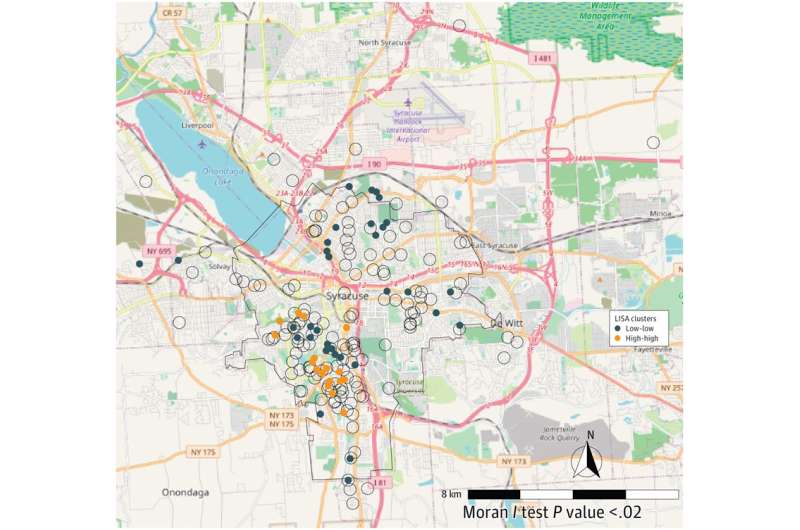This article has been reviewed according to Science X's editorial process and policies. Editors have highlighted the following attributes while ensuring the content's credibility:
fact-checked
peer-reviewed publication
trusted source
proofread
Q&A: First-of-its kind research studies arsenic exposure in Syracuse children

A new study published in the journal JAMA Network Open studies the connections between arsenic exposure and cardiovascular disease processes in children.
Led by Brooks B. Gump, Ph.D., M.P.H., the Falk Family Endowed Professor of Public Health in the Falk College, the research group considered arsenic exposure and health data of 245 children in the Syracuse, New York, metropolitan area. It is the first study to directly measure the associations between arsenic exposure and precursors to cardiovascular disease in children.
The study's findings are important because they highlight the need to reduce arsenic exposure in children. Arsenic is a naturally occurring element that can be found in soil and water. It can also be released into the environment from industrial activities.
In this Syracuse News Q&A, Professor Gump shares details about how this research can contribute to safer public health standards, and how arsenic exposure in children potentially accelerates the development of cardiovascular disease in adults.
Q: Can you briefly explain your research findings related to arsenic exposure and the health impacts on children?
A: Arsenic was measured in urine as well as several measures of subclinical cardiovascular disease . This arsenic exposure was significantly associated with some of the health outcomes, including increasing vascular "thickness" and heart changes. These particular cardiovascular changes can predict later disease. Given this was not a clinical trial (it would be unethical to purposively expose children to arsenic), we made a point of controlling for many other factors, such as poverty.
Q: How do you measure 'arsenic exposure?'
A: Arsenic exposure is best assessed using urine, as we did in this study. These levels are considered an indicator of cumulative but relatively recent arsenic exposure.
Q: How do the results found in children compare to adults who have been exposed to similar conditions?
A: Adults have shown some of the same associations between arsenic and cardiovascular disease—this is the first study to document these associations in a group this young. However, it should be made clear that this is not actual disease but rather a risk factor for future disease (such as elevated cholesterol),
Cardiovascular disease develops very slowly, beginning at a very young age and potentially developing into a diagnosable disease later in life.
Q: From a prevention standpoint, what can parents and caregivers do to protect their kids?
A: Given arsenic is now so commonly found in our environment, one of the best actions we can take is to first lower what is considered a "normal" level (<50 mcg/L; although CDC now states that any level is considered too much). This will automatically move many children into "elevated" levels which should precipitate a federal response to address this "new" public health issue. We are also planning new research to consider specific foods we could eat to reduce arsenic in the body.
Q: Your findings suggest an area southeast of Onondaga Lake could be a sort of 'hotspot' for arsenic exposure, potentially tied to past industrial pollution. Can you explain how pollutants persist in the environment?
A: Because metals such as arsenic are elements (not chemical compounds), they cannot degrade in the environment. As such, they may move around or recombine in the environment but do not disappear over time. Although water in some geographic areas has harmful but naturally occurring arsenic, arsenic is also used in industry and agriculture and thereby has spread into the community.
Q: Your findings were specific to Syracuse, but the infrastructure features and historic pollution of Syracuse are conditions seen in many other US cities. How could your research provide answers for other locations?
A: Although arsenic urine levels in our cohort were slightly elevated relative to national averages—there are numerous such hotspots around the country and therefore it is very likely that other communities in the U.S. would also show similar associations between arsenic and disease.
Q: Was there anything that truly surprised you during the research process or in the findings?
A: Although hypothesized, we were still struck by the effect of arsenic being seen at such a young age (9–11 years old). There are many risk factors for cardiovascular disease, even in children—including stress, diet, lack of exercise, and cholesterol. Perhaps arsenic should be added to this list of risk factors that should be monitored and addressed.
More information: Brooks B. Gump et al, Exposure to Arsenic and Subclinical Cardiovascular Disease in 9- to 11-Year-Old Children, Syracuse, New York, JAMA Network Open (2023). DOI: 10.1001/jamanetworkopen.2023.21379





















